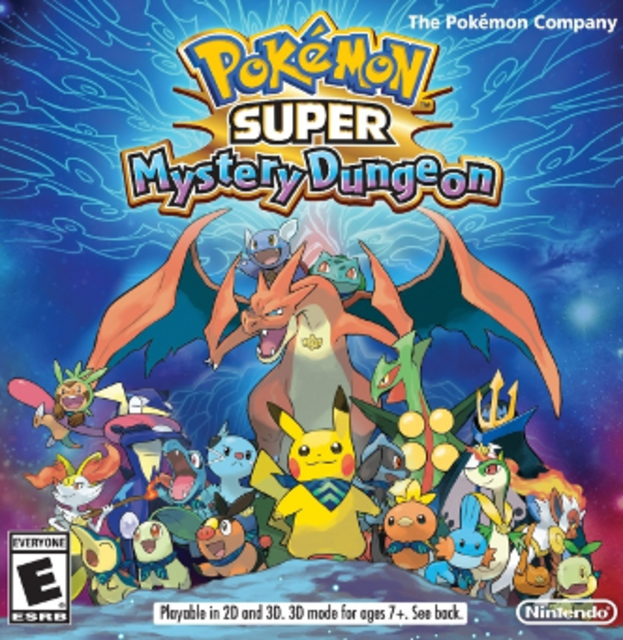A frustrating, but compelling, adventure
Pokémon Mystery Dungeon has always been something of an oddity. While always receiving mixed reception from critics, the games consistently sell well and have a very, very passionate fanbase.
I’ve not had too much history with the series. I played Red Rescue Team, and while I enjoyed it, the roguelike gameplay proved to be a bit too much for me to handle at the time. But I’ve been on a major Pokémon kick lately, and figured that the time was now to give the series another shot, now that years of indie roguelikes have prepared me.
The game opens up with a personality quiz to determine the Pokémon you play as, which was present in the first two games before being scrapped for Gates to Infinity. It remains more or less the same as it did before, with dreamlike visuals & music combined with weird questions that have basically no relation to the Pokémon you get. It makes one smart change. however: you can now scrap the Pokémon you were given and choose another one. This is a smart change, because nobody wants to play as a Chikorita, and aggressively restarting to get the one you want isn’t much fun. I selected Torchic for the protagonist, and Piplup for the partnering Pokémon.
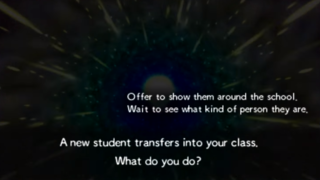
The biggest problem with the story is that the pacing is of two extremes. One extreme is the extremely sluggish pacing within the first half of the game. The first ten chapters (out of 22) take place in Serene Village, and most of its events feel disconnected from the other half. Only a handful of characters from this area play any major role afterwards, and the result ends up feeling like a drag. Chapter 9 is a perfect example of this: Nuzleaf suggests that the blatantly named “Revelation Mountain” could contain the answers to the identity of the protagonist. After 7 floors of dungeon crawling with dramatic music in the background, they end up coming across some guards and decide to just give up and head home. It is infuriating. The game teases you with major plot development, but ends up pushing it until later in the game.
This slow opening means that once the main characters decide to bail and join the “expedition society” in Lively Town, the game is nearly halfway over and thus hits the other extreme, with the rest of the plot feeling incredibly rushed and plot twists being shot out with the speed of a gatling gun. This leads to some very, very long scenes of exposition.
However, if you can look past the pacing, the plot is still enjoyable. The aforementioned plot twists are pleasingly ludicrous but still well foreshadowed, and most of the characters are likable. (Except Jirachi, smug piece of shit.) The game gives life and personality to just about every Pokémon, even those that nobody cares about. The protagonist remains curiously underdeveloped compared to the partner, however.
PSMD changes a lot about the way previous games worked. The biggest change is in the new “connection orb” system. In previous games, recruitment was random: after defeating an enemy, they would occasionally ask if they could join your team. It wasn’t satisfying, and led to nonsense like this.
Now, there are two ways of recruiting party members. The first is this:
- Select a request via either the connection orb menu or talking to an NPC
- Go to the dungeon, do what they request
- You’ll “connect” with them, meaning that they are able to be used in teams.
The missions themselves are fairly similar to what was before. Deliver an item to a Pokémon in the dungeon, retrieve an item, or the incredibly creative “get to the end of the dungeon!” The game doesn’t even try to contextualize that one. One notable new mission type is when a Pokémon asks for a meet up at their secret base!. This involves exploring a floor until the Pokémon who submitted the request welcomes the party. Either they will happily talk to you, or pull a fast one and reveal it’s a monster house, a room filled with Pokémon who want to maul the party.
The second way of connecting with Pokémon is simply by talking to them out in the hub world. There’s a line of dialog initiating a conversation, a cut to black, then a line of dialog closing it. This leaves a lot to the imagination. For example, this is a conversation with Magby:
You know, the Vice Principal is kinda…
…
Thank you for your time!
By the way, don’t you think the vice principal is really unique?
Who knows what the full conversation is like? Since the last sentence starts with “by the way”, it appears the vice principal is more than “unique”. The game leaves a lot to the imagination in this regard. For example, I will now imagine that they (Watchog) is secretly another human who robbed a bank, killed all of the hostages, and escaped capital punishment by entering the Pokémon world. He stares at the students, plotting their demise.
You come up with your own theories. It can be tedious constantly running around, checking the map for each region and seeing who you haven’t talked to, but what they say is charming enough to overlook it.

Overall, the connection orb system is a much smarter way of unlocking new Pokémon to play as, since it feels like you’re actually accomplishing goals instead of just getting lucky. The system does mean that once you’ve done all of the quests that there isn’t much reason to go back into dungeons, but considering that doing all the quests is a good 80 or so hours of content, it’s hard to be too upset. The system does suffer from one annoying design choice, though — occasionally, a party member may be unavailable to join the party because they’re off doing their own thing. It’s clear that this is to prevent players from just using broken Pokémon over and over again, but it’s maddening when you have the next objective planned but find that one essential Pokémon is unavailable. At the very least, it needs to be made more clear when a Pokémon will be unavailable and how long they’ll be gone for.
While the dialogue is great, the actual localization doesn’t always live up to it. While by no means bad, it feels like it’s a bit closer to Pokémon Red/Blue in quality than the excellent script of the Gen VI games. The script generally works, but often comes across as somewhat stilted. One example is a late-game scene where there’s an imposter hanging around. In the Japanese version, this is noticed when they use “I” instead of “Myself”. Since this is nonsensical in English, it is instead noticed when they say “seen” instead of “saw”. This…sort of works, but comes across as kind of weird. That’s a common grammatical mistake, it shouldn’t really be a tip-off. The localization needed to be a bit less faithful and overhaul some of the script for scenes like these for work. For example, if the character being impersonated was given a catch-phrase, like, say… “D’oh!”, the impostor could have instead said “B’oh!”, which would have worked as far more effective a tip-off. It feels a bit too faithful to the Japanese script for its own good. The changes that are made aren’t always great, either, the highlight being Nuzleaf’s accent. He talks in an utterly bizarre Texan accent that makes hard to take him seriously, and a lot of scenes in the game that are meant to be taken seriously instead become laugh-out-loud funny due to it. The localization isn’t bad, and it has well done parts (such as how Hawlucha calls his fans “Hawluchamaniacs”) but at the same time it’s hard to praise it. On a localization quality scale from Zero Wing to Ace Attorney, PSMD sits squarely at the middle.
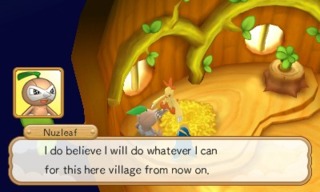
Of course, that’s all well and good, but the elephant in the room is that in previous games, the dungeon crawling could get extremely repetitive. PSMD does a lot to alleviate this. As in the previous games, you are tasked with taking a party throughout randomly generated dungeons, defeating enemies, getting XP, and yelling at the screen about how your teammates are morons. The Hunger mechanic returns after being absent in Gates to Infinity, so you’ll need to keep the bag filled with food. One of the key distinctions in PSMD, however, is that the game encourages use of more of the game’s abilities than before. For example, in previous games, “Tackle” was bound to the A button, and would generally do enough damage to get by without having to use your actual moves. Now, it’s still bound to A, but is now a fixed attack that does a whopping 5 points of damage. I don’t know why they even bothered. Thankfully, they also made moves easier to access, since they can now be brought up by simply holding L instead of having to go through the Menus.
You’ll want to use everything available to you, as PSMD can be surprisingly difficult. While it’s no Shinen the Wanderer, the game marks its territory early on with a connection orb request by Axew. It’s to defeat a Pokémon laying at the fourth floor of Lush Forest, a very easy dungeon. The mission even has a one-star difficulty. The catch? That Pokémon is a Level 50 Salamance. Bear in mind, at this point, you’ll be about level 9. Most players don’t last long at this point. Salamance isn’t actually too difficult to defeat with the right items, but the game makes its point and makes it clear: PSMD isn’t fucking around. If you aren’t constantly prepared for the worst possible situations, you will suffer the consequences. Enemies hit hard, and they’ll very frequently walk right up to you and take the entire party out in one go. Exploring dungeons is wildly unpredictable as a result. As maddening as it can be, it is also much more exciting, since even the simplest missions can go off the rails in an instant.
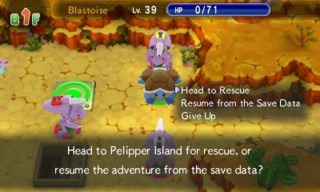
Granted, the imbalance works both ways. Enemies hit hard, but party members can hit harder. The game has a ton of items to do this, such as blast seeds which shoot a fire ball that does 100 damage, wands that can warp enemies to another part of the map, confuse them, tunnel through walls, or change their ability to Truant. Then there’s the gold bar exchange. Gold bars are acquired when the “expedition rank” goes up, and at random from chests and on the ground. They can be given to Cofagigus for money and items - the game really highlights here how much they expect party members to be knocked out, since 1 gold bar will give 5 reviver seeds, which are effectively 1-ups. In contrast, Gates to Infinity required 2 gold bars for 1. As such, it is very easy to stock up on tons of reviver seeds, and, with how quickly a party member can be knocked out, you’ll need every one. In addition to that, Cofagigus also sells items that can boost a stat permanently. As Miiverse will gleefully demonstrate, this can lead to some ridiculous stats. In general, it feels like Spike Chunsoft realized that the game was wildly unfair, and instead of nerfing the enemies, buffed the hell out of all the attacks and items available. The result is a completely unbalanced mess, but it’s a fun completely unbalanced mess, one that requires rigorous abuse of the mechanics to make progress.
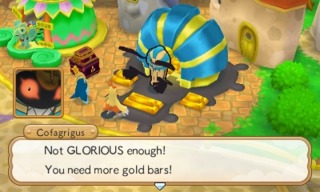
One of the biggest complaints about Mystery Dungeon games, and randomly generated games in general, is that the dungeons themselves tend not to be especially memorable. Every dungeon run feels more or less the same — running about, picking up items, defeating Pokémon and occasionally swearing at the screen before moving onto the next floor. PSMD attempts to alleviate this by introducing Looplets. These are held items brought into dungeons, and have special attributes when held, such as boosting stats or making the Pokémon immune to weather effects. However, their real purpose is that a limited amount of “Emeras” can be inserted into them, which can be found in the dungeons. Emeras are solely for the current dungeon and have a wide variety of special effects, some of which are straightforward “increase critical hit rate” or “hunger doesn’t go down as fast” while others are slightly more esoteric, such as “attackers occasionally warp to elsewhere on the map” or “The A button now sends the enemies flying ten tiles away”. While it doesn’t lead to quite as much variety as something like The Binding of Isaac, it still makes dungeons more interesting than they have been in the past. Figuring out how Emeras can work together and be abused gives a sense of discovery within the mechanics. As is to be expected, there are some insanely overpowered Emeras, with the highlight being “Ally Revive”, which, when equipped by the party leader, revives allies for free. Just keep the leader in a safe spot, and you’re golden.
The Emera system is also how Mega Evolution is incorporated — If a Pokémon with a Mega form equips the “Awakening” Emera, they will Mega Evolve. This lets them burrow through walls, and gives them a major buff in battle. However, this is only good for a limited number of turns, as eventually they will enter rage mode and start attacking wildly. Usually in the direction of your party members. In-universe, this makes some sense — Mega Evolution in the main games requires a talented trainer with a strong bond, so in a world without trainers, it stands to reason that it wouldn’t be especially helpful. Which doesn’t mean that it isn’t an underwhelming mechanic, especially considering that Awakening Emeras are pretty rare to begin with.
Pokémon Super Mystery Dungeon is a weird game. On paper, it’s not an especially great game. The pacing is a mess, the gameplay is wildly unbalanced, occasionally unfair, and downright maddening, but ultimately, I’ve put 55 hours into it, with 25 of those being the main story. The unpredictable nature of the gameplay makes it a lot more thrilling than it would otherwise be, and the story and characters are still greatly enjoyable once it gets going.
It stands in stark contrast to the mainline Gen VI games. X/Y and ORAS are very easy games, designed so that any idiot kid can spam Pikachu’s thunderbolt and do alright. PSMD, on the other hand, is more than willing to kill you immediately unless you’re ready to abuse everything at your disposal. It’s a tough game to recommend, but if Gen VI’s easy difficulty left you disappointed, this might just be what you’re looking for.
